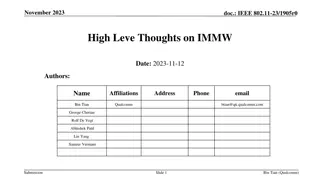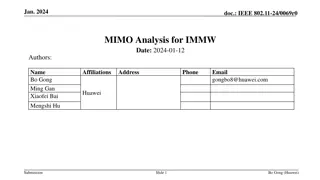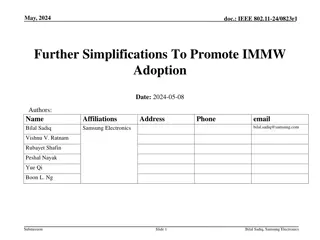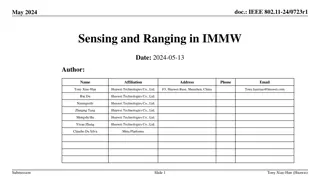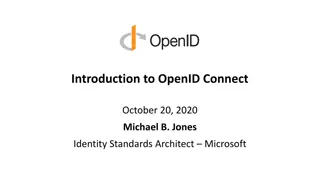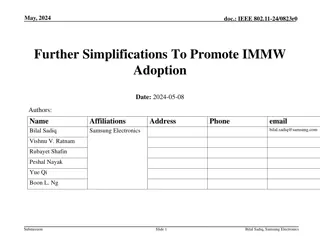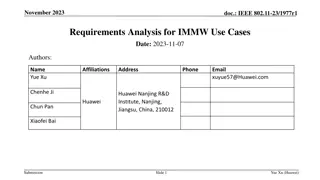IEEE 802.11-25/0261r2 IMMW for Mobile Device and TGbq Timeline
Scope of the project includes non-standalone operation in 42-71 GHz, leveraging existing PHY/MAC defined for sub-7.25 GHz bands. The project aims to support new applications with demands for throughput, latency, and accuracy in dense environments while ensuring cost-effectiveness. Specific values and considerations for IEEE 802.11-25/0261r2 IMMW SG contributions are discussed, emphasizing the use cases and considerations for consumer mobile devices like high throughput hotspots and AR/VR applications with low latency and proximity detection.
Download Presentation

Please find below an Image/Link to download the presentation.
The content on the website is provided AS IS for your information and personal use only. It may not be sold, licensed, or shared on other websites without obtaining consent from the author.If you encounter any issues during the download, it is possible that the publisher has removed the file from their server.
You are allowed to download the files provided on this website for personal or commercial use, subject to the condition that they are used lawfully. All files are the property of their respective owners.
The content on the website is provided AS IS for your information and personal use only. It may not be sold, licensed, or shared on other websites without obtaining consent from the author.
E N D
Presentation Transcript
How to Move High Volume Data to HDFS (APACHE SQOOP) Project Presentation SYSC 5807 -Advanced Topics in Computer Systems Professor Imran Ahmad, PhD By, AesumonSunny George (101030592) Antony AntyKannampilly (101053630) Jipson Johnson (101028751) 4/13/2025 1 ShagunGoel (101055437)
What is Covered What is Sqoop Why Sqoop How Sqoop Works Who Uses Sqoop Importing and exporting data using Sqoop Data Import in Hive and HBase with Sqoop Conclusion References 4/13/2025 2
What is Sqoop? Sqoop is a tool designed to transfer data between Hadoop and relational database servers It moves High volume data to Hadoop HDFS It is used to import data from relational databases such as MySQL, Oracle to Hadoop HDFS It also exports data from Hadoop file system to relational databases Transforms data in Hadoop with MapReduce or Hive 4/13/2025 3
Why Sqoop? SQL servers are already deployed and established worldwide As Hadoop is making ways into enterprise, there was a need to move certain part of data from traditional SQL relational databases into Hadoop Transferring data using scripts is inefficient and time consuming Traditional DB already have reporting, data visualization applications built in enterprise .Bringing processed data from Hadoop to those applications is the need. 4/13/2025 4
Cont From RDB to Hadoop : Users must consider details like ensuring consistency of data, the consumption of production system resources, data preparation for provisioning downstream pipeline Hadoop to RDB : Directly accessing the data residing on eternal systems from within the map reduce applications complicates applications and exposes the production system to the risk of excessive load originating from cluster nodes 4/13/2025 5
What Sqoop provides Sqoop allows easy import and export of data from structured data stores RD, Enterprise data warehouses and NoSQL systems Provisions data from external system on to HDFS Once data is moved ,populate tables in Hive and HBase Sqoop integrates with Oozie, allowing you to schedule import and export tasks Sqoop uses a connector based architecture which supports plugins that provide connectivity to new external systems 4/13/2025 6
How Sqoop works 4/13/2025 7
Cont Sqoop import tool imports individual tables from RDBMS to HDFS Each row in a table is treated as a record in HDFS All records are stored as text data in text files or as binary data in Avro and Sequence files Sqoop export tool exports a set of files from HDFS back to an RDBMS The files given as input to Sqoop contain records, which are called as rows in tables Those are read and parsed into a set of records and delimited with user-specified delimiter 4/13/2025 8
Who uses Sqoop? Online Marketer Coupons.com uses Sqoop to exchange data between Hadoop and the IBM Netezza data warehouse appliance. The organization can query its databases and pipe the results into Hadoop using Sqoop Education company The Apollo group also uses the software not only to extract data from databases but also to inject the results from Hadoop jobs back into relational databases And countless other hadoop users use Sqoop to efficiently move their data 4/13/2025 9
Sqoop Commands 4/13/2025 10
Importing Data Command * $ sqoop import --connect jdbc:mysql://localhost/testdb \ --table TABLE_NAME --username USER_NAME --password PASSWORD Import * Subcommand --connect & --username & --password * Part of connection string * A regular JDBC connec --table * Database table name 4/13/2025 11
How Sqoop Import works Step 1: Sqoop introspects the database to gather the necessary metadata for the data being imported Step 2: A Map-only Hadoop job is submitted to cluster by Sqoop The Map-only job performs data transfer using the metadata captured in Step 1 4/13/2025 12
How Sqoop Import works The imported data is saved in a directory HDFS based on the table being imported User can specify any alternative directory where the files should be populated By default these files contain comma delimited fields, with new lines separating different records User can override the format in which data is copied over by explicitly specifying the field separator and record terminator characters 4/13/2025 13
Importing Data into Hive --hive-import Appending above to Sqoop import command. Sqoop takes care of populating the Hive metastore with the appropriate metadata for the table and also invokes the necessary commands to load the table or partition Using Hive import, Sqoop converts the data from the native datatypes within the external datastore into the corresponding types with Hive Sqoop automatically chooses the native delimiter set used by Hive. If the data being imported has new line or other Hive delimiter characters in it, Sqoop allows you to remove such characters and get the data correctly populated for consumption in Hive After the import get completed, user can operate table just like any other table in Hive 4/13/2025 14
Importing Data into HBase Sqoop can populate data in particular column family in HBase table A column family is a NoSQL object that contains columns of related data HBase table and column family setting is required in order to import table to HBase Data imported to HBase is converted to their string representation and inserted as UTF-8 bytes 4/13/2025 15
Importing Data into HBase --hbase-create-table --hbase-table $ sqoop import --connect jdbc:mysql://dataset_server/dbname \ --table table_name --username user_name --password password\ --hbase-create-table --hbase-table hbase_table_name --column- family DB_type_Setting --hbase-create-table Instructs Sqoop to create the Hbase table --hbase-table Specifies table name to use --column-family Specifies the column family name to use For MySQL mysql 4/13/2025 16
Sqoop Connectors Generic These are the most basic ones that uses the JDBC interface for accessing metadata and transferring data. Specialised These are the custom Sqoop connectors that may or may not depend on JDBC e.g.; Netezza, Teradata, SQL Server, Oracle. 4/13/2025 17
Exporting Data from Hadoop using Sqoop h The export tool exports a set of files from HDFS back to an RDBMS The target table must already exist in the database. The input files are read and parsed into a set of records according to the user- specified delimiters export-dir -> The HDFS folder from where the data will be exported $ sqoop export --connect jdbc:mysql://database_server/dbname \ --table target_table_name --username user_name --password \ --export-dir /home/cloudera/hivedb/testbl 4/13/2025 18
Exporting Data using Sqoop h Step 1 Introspect the database for metadata Step 2 Transfer the data Sqoop divides the input dataset into splits Sqoop uses individual map tasks to transfer the splits to the dataset Each map task perform this transfer over many transactions in order to ensure optimal throughput and minimal resource utilization 4/13/2025 19
Conclusion The apache Sqoop tool is the most popular and efficient means to transfer high volume data into HDFS The importing, exporting and manipulation of large volume data has become a necessity with the growing popularity of content based network architectures and Hadoop and apache scoop answers this An implementation will be done showing how a large volume data from database will be transferred to HDFS, processed and returned back to the database. 4/13/2025 20
References https://sqoop.apache.org/docs/1.4.2/SqoopUserGuide.html #_literal_sqoop_export_literal https://blogs.apache.org/sqoop/entry/apache_sqoop_overvi ew https://hive.apache.org/ http://hbase.apache.org/ https://www.tutorialspoint.com/sqoop/ https://en.wikipedia.org/wiki/Sqoop https://hortonworks.com/apache/sqoop/ 4/13/2025 21
Thank You 4/13/2025 22



